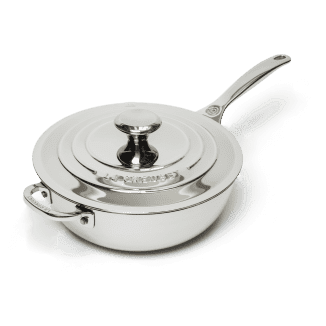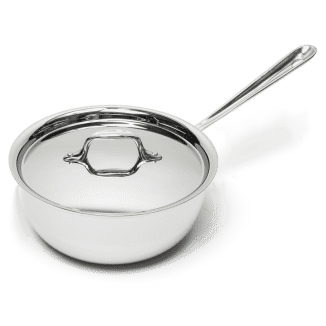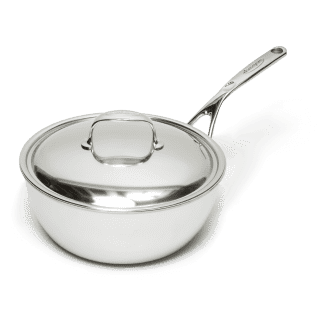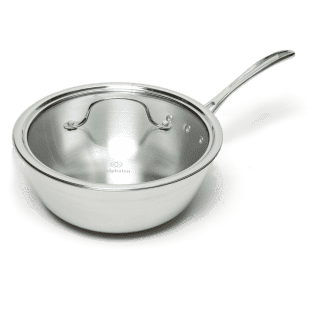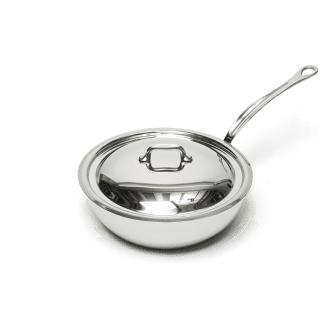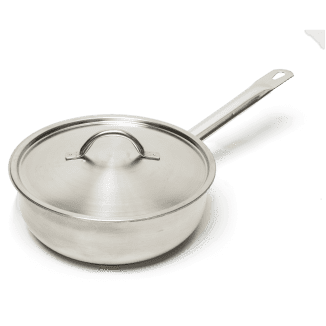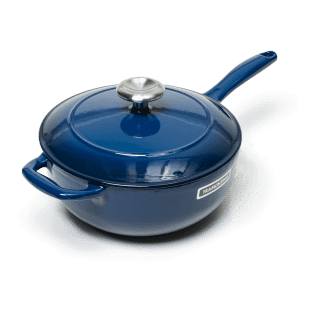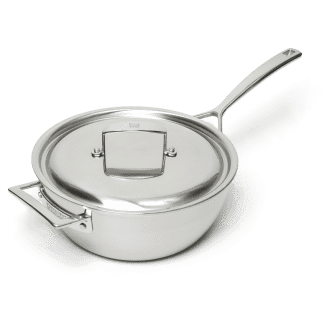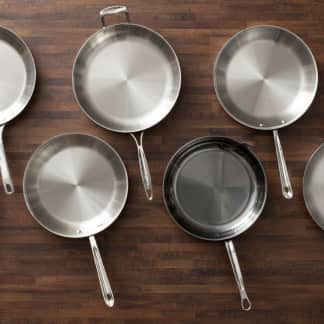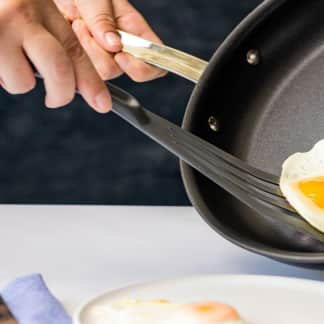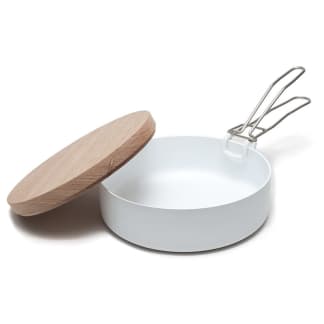Mention the word “saucier” in the test kitchen, and you’re in for an earful. The loyalists among us rave that these vessels, which are essentially rounded saucepans with wider mouths, flared walls, and rolled lips, can do everything a conventional saucepan can do—and that their distinct design features make some cooking tasks even easier. These include preparations like oatmeal, risotto, and polenta, where the food is prone to getting lodged in corners and burning, as well as custards and sauces that require frequent stirring. And as their name and wide-mouth design imply, they’re built for reducing sauces. (“Saucier” is also the name given to French cooks who prepare sauces, stocks, and soups.) And though models vary in shape and size, sauciers offer depth and capacity, as well as easy access to their interiors and corner-free surfaces that are easy to clean.
But while a saucepan is standard in any kitchen, sauciers have mainly been the domain of restaurant chefs. We thought it was time this changed. We gathered eight models with capacities ranging from 3 to 3½ quarts—the most common large size—and compared them with our favorite 4-quart saucepan from All-Clad. Six of these pans were fully clad, meaning they were made of alternating layers of steel and aluminum, which takes advantage of the best qualities of each metal. We also tested a “disk bottom” model (only the base is fully clad, and the sides are a single layer of stainless steel) and a hefty model made of enameled cast iron. In them, we prepared risotto, gravy, and pastry cream, noting their cooking performance as well as how comfortable they were to maneuver. We also tested their reduction speed by boiling a measured amount of water in each model for 10 and 20 minutes and weighing the results. Finally, since their curvy sides are known for being easier to clean than the L-shaped sides of saucepans, we washed each model by hand.
While a saucepan is standard in any kitchen, sauciers have mainly been the domain of restaurant chefs. We thought it was time this changed.
Surface Tensions
The good news: Every model delivered creamy risotto, satiny gravy, and smooth pastry cream, and it was a pleasure to whisk and stir in most of them. Our utensils glided against their curvy walls—a noticeable difference from the stiffer, bumpier movements they made in the saucepan. The Paderno was the exception; its L-shaped corners meant that it behaved more like a saucepan, trapping custard and rice.

The diameter of the base separated top performers from lesser models, affecting how frequently we had to stir the contents to ensure that food cooked evenly. When softening aromatics for risotto and gravy, testers using sauciers that measured less than about 5¾ inches across the bottom had to stir continuously, lest the vegetables pile atop one another and steam. The same diligence was also required if the base was too broad, since the too-thin layer of vegetables was prone to scorching. Pans with bottom surfaces measuring between 5¾ and 7 inches were best.
As for reduction rates, water evaporated faster in all of the sauciers than it did in the All-Clad saucepan; the fastest, by Le Creuset, evaporated about 13 percent more water than the saucepan did after 20 minutes. That’s proof that these flared pans are more efficient for sauce-making, though the disparity isn’t so great that a recipe designed for a saucepan will fail in a saucier. When using a saucier, expect that the food might be done on the earlier end of the cooking time range.
How’s It Handle?
The more distinct discrepancy among these pans was their overall design: the size and shape of their handles, how much they weighed, and how comfortable they were to maneuver. All testers struggled with stumpy, skinny, or sharp-edged handles that slipped from or dug into our palms, and we docked points from models with handles that became too hot and forced us to use potholders. The best models sported relatively long (about 8 inches), wide (2½ to 3 inches around) handles that were easy to grasp, stayed relatively cool, and offered enough leverage to lift the saucier with one hand.
The more distinct discrepancy among these pans was their overall design: the size and shape of their handles, how much they weighed, and how comfortable they were to maneuver.
The cast-iron Tramontina literally sank into last place. Clocking in at nearly 6 pounds, it outweighed every other pot by at least 2 pounds and was a bear to maneuver. Other, less-heavy models felt just as solid, and none chipped or scratched when we sharply rapped them with a metal utensil.
But there were also a few lighter-weight models that were cumbersome to handle, thanks to the awkward angle at which the handle extended from the bowl. For example: The handle on the lighter-weight Mauviel pot jutted so sharply that testers struggled to move it. Likewise, the handle on the hefty Demeyere curved steeply upward and offered little leverage. According to Jack Dennerlein, professor of ergonomics and safety at Northeastern and Harvard Universities, the key consideration is “the line of your hand and forearm compared to the line of the pan,” which affects how much leverage you have.
Getting a Good Angle
Better balance and weight distribution depend on the handle’s angle. The more parallel the handle is to the pot rim, the more leverage you have and the lighter the pan feels in your hand.
Finally, there was cleanup—which might be the most convincing reason to invest in a saucier. In the best models, the absence of sharp corners meant not only that there was nowhere our utensils couldn’t reach and no crevices in which rice grains or drops of custard could get stuck, but that it was easy and natural to swipe a sponge along the curved walls and wipe out every speck of food.
Our favorite, the Le Creuset 3½ Quart Stainless Steel Saucier Pan has it all: Its wide bowl with walls that slope gently down to a 5¾-inch cooking surface encouraged broad, efficient strokes with a whisk, rubber spatula, or sponge. The long, wide, comfortable handle gave us great control, and its relatively straight extension from the pot made it easy to maneuver. It’s pricey and won’t replace our favorite All-Clad saucepan—the latter’s 4-quart capacity is a must for any kitchen—but give this pan a spot on your pot rack and you’ll be reaching for it almost every day.
The Tests
- Stir Parmesan Risotto
- Sauté Vegetables
- Reduce Broth to Make Gravy
- Whisk Pastry Cream
- Evaluate Reduction Speed
How We Rated
- Performance: We stirred Parmesan risotto, sautéed aromatic vegetables and reduced broth to make gravy, and whisked pastry cream. To test reduction speed, we filled each model with 1,840 grams (about 8 cups) of 75-degree water, timed how long each took to boil over high heat on the same burner, boiled the water for 10 minutes, weighed the results, and repeated the weighing again after 10 more minutes of boiling. Sauciers received high marks if they produced good-quality results in the three recipe tests and offered a relatively broad cooking surface and a rounded shape that made it easy to stir and whisk.
- Ease of Use: We evaluated the length, circumference, and angle of the handles, as well as the weight of the pans (without lids)—all of which contributed to the pans’ ease of use.
- Cleanup: We washed the sauciers by hand throughout testing, noting how easy they were to scrub with a sponge and whether or not they showed any visible scrub marks, scratches, or discoloration.
- Relatively Broad Cooking Surface
- Smooth, Curvy, Gently Flared Walls
- Well-Designed Handle
- Moderate Weight

